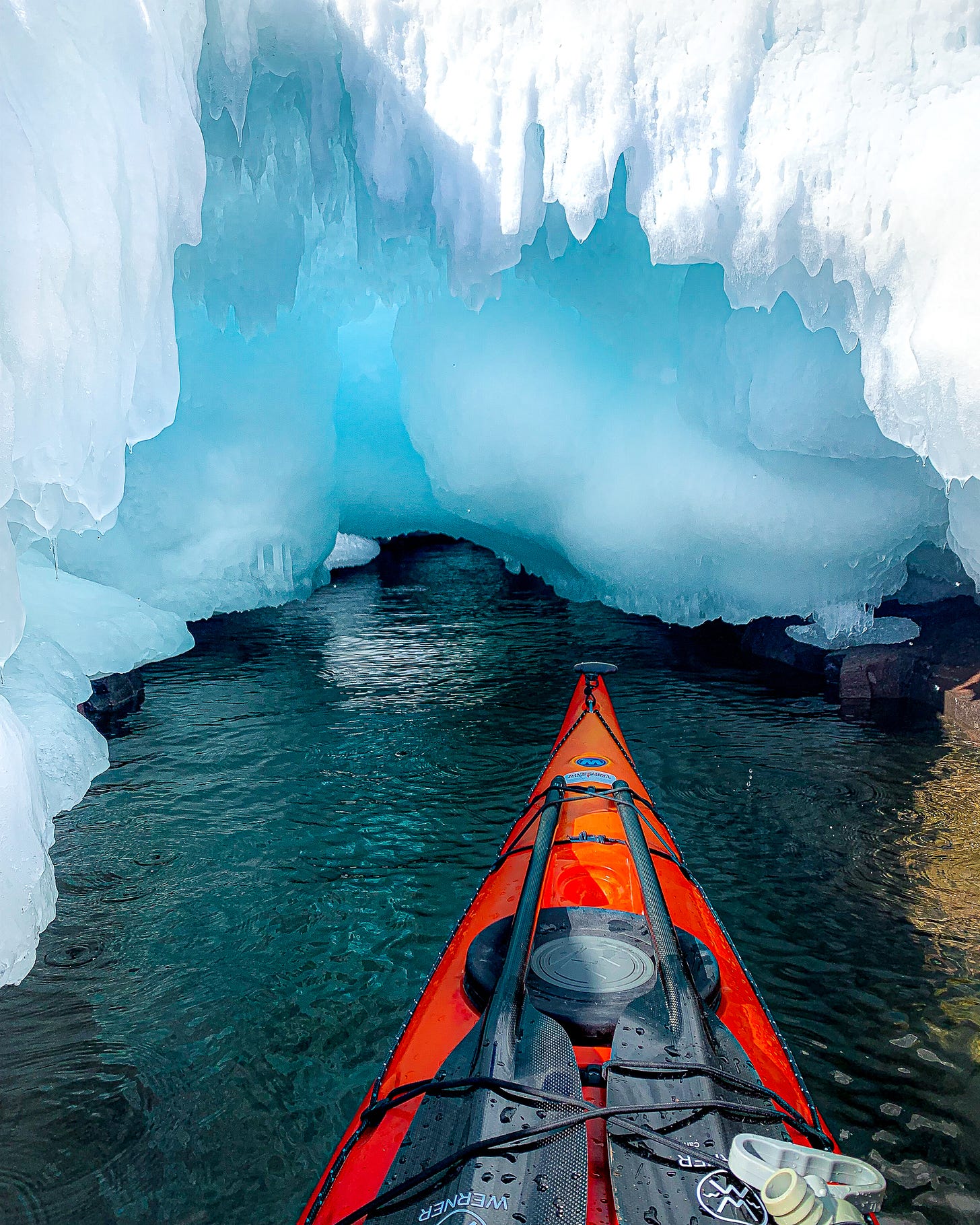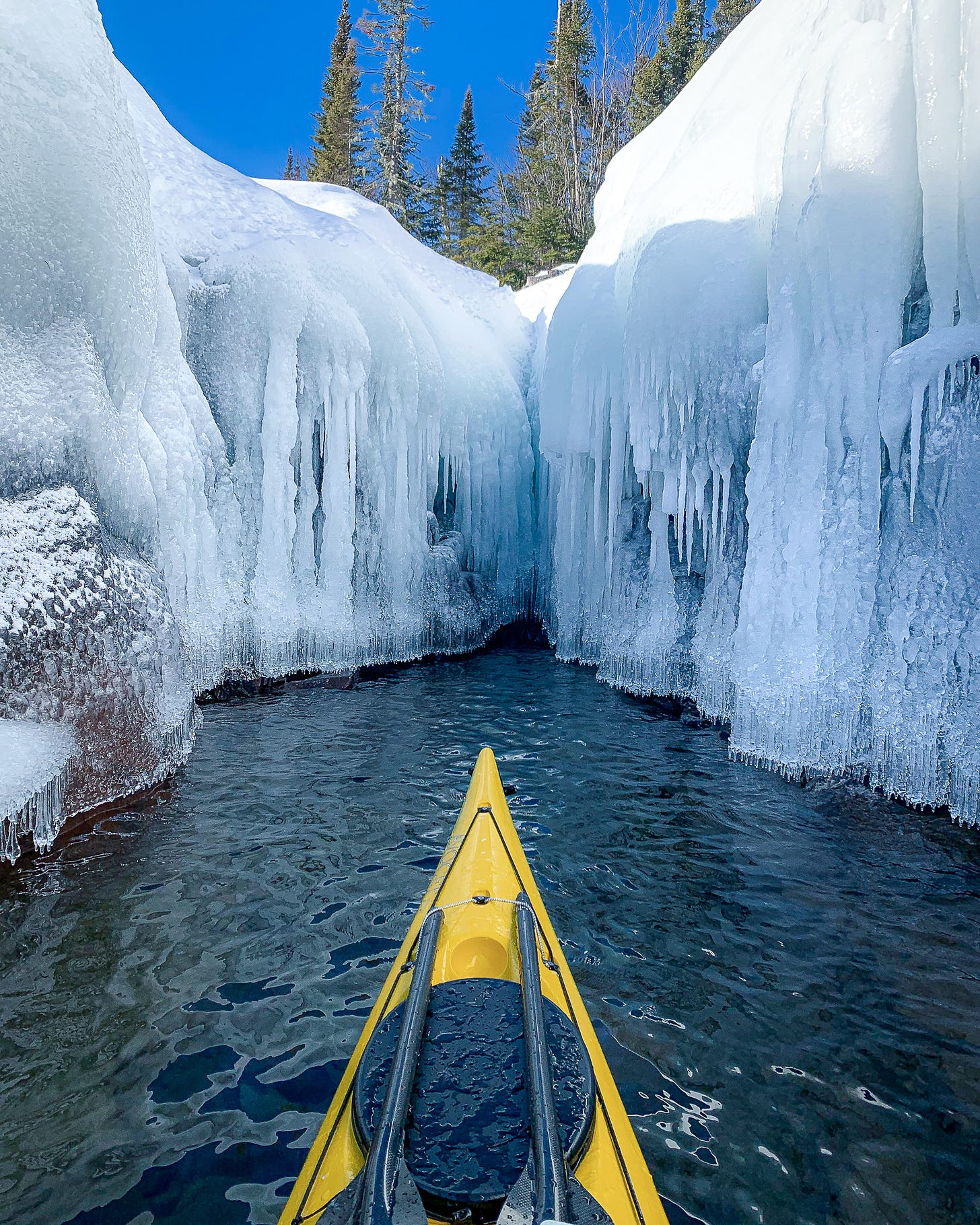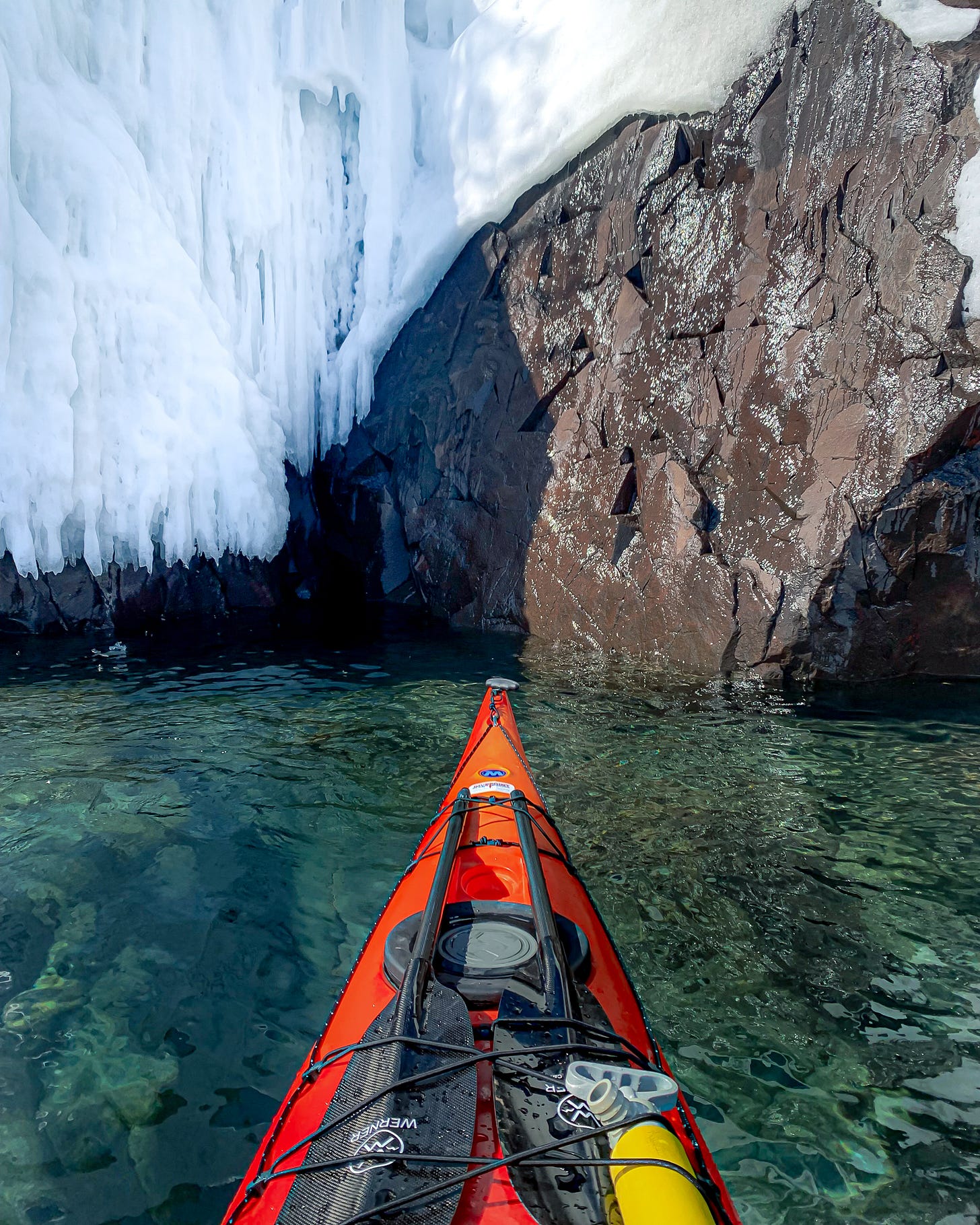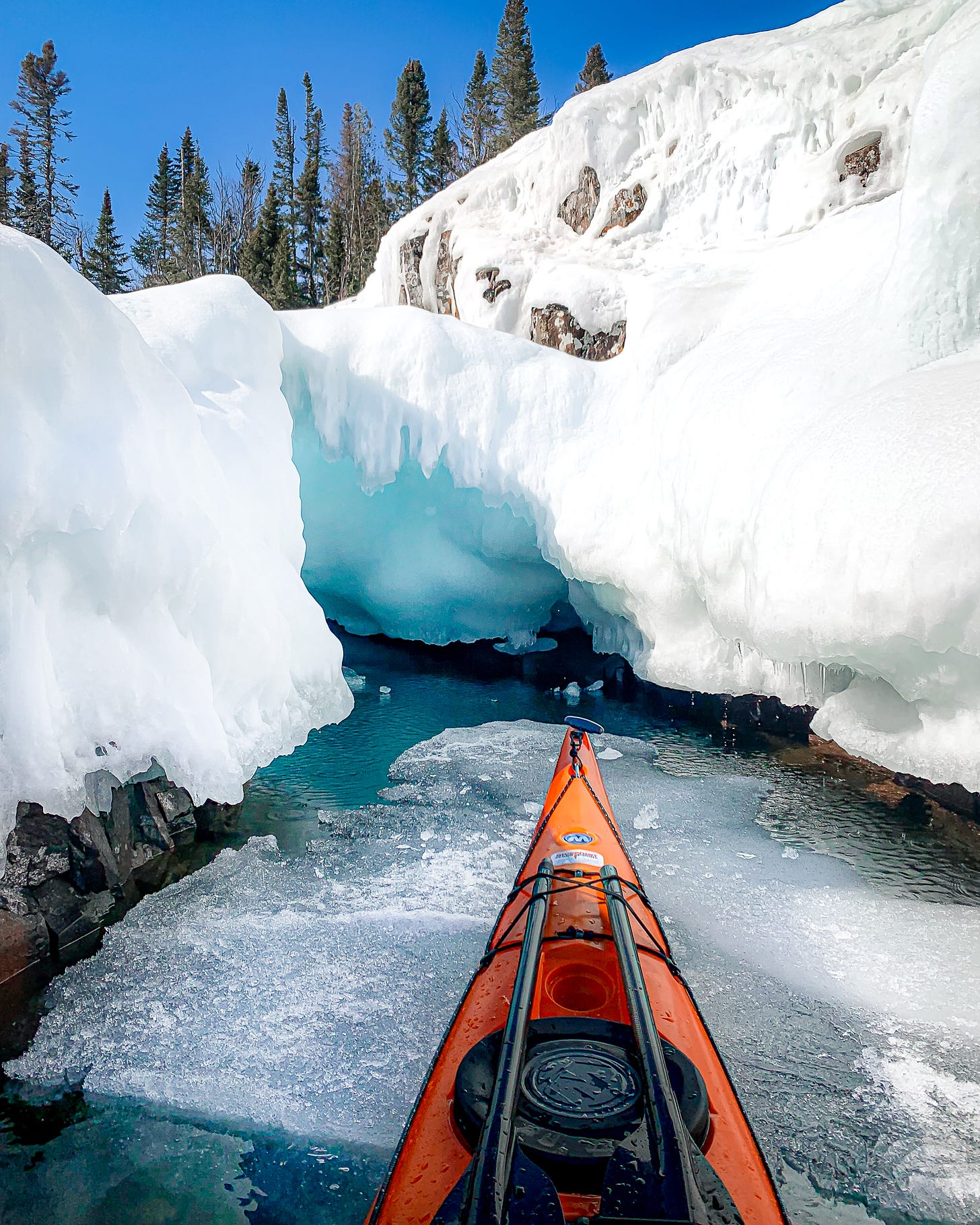If you’re over on the paywalled section of Hello Stranger, you probably already know that this summer Andy, our friend Ebba, and I are planning a sea kayak expedition this summer and planning to paddle roughly from Bellingham, Washington to Glacier Bay National Park, Alaska.
This 1200-1300 mile route is called the Inside Passage. It’s largely protected from the full force of the Pacific, there are towns and resupply points every few weeks, we’re expecting to take about three months but giving ourselves four, and I’ve been dreaming of this trip and planning and reading about it for about five years.
If you’re not over on the paywalled section yet and want access to the behind the scenes planning content, or want to help support some of our trip expenses, subscribe below!
In the meantime, we found Glacier Bay a little early right here in Northern Minnesota.
Sunday we had just glassy waters and unseasonably warm temperatures, so we hit the water to poke around a little bit. It had been a while since I’d been out on the water, and with all of the planning I’ve been doing this month to get ready for May I was viscerally craving it.
The Orange Wilderness Systems Tempest pictured above is a new to me boat! My usual ride, the yellow Avocet LV pictured below will be sitting this trip out. I’ve taken the 15’11” Avocet on several 2-3 week kayak trips, and isn’t ideal for long distance paddling. The Avocet is squirrelly in large following seas and doesn’t pack much gear. I love my boat and it’s perfect for about 90% of the paddling I do, but it’s not a trekker.
I wanted something with a little more volume and length for this trip. A plastic boat like the Tempest above can also take a little more abuse than the fiberglass Avocet, and to be honest I’ve already put the Avocet through the wringer and spent a good portion of last summer doing repairs. I’m not sure it would be wise to subject her to a 1300 mile beating.
Compared to the Avocet, the Tempest is solid as a rock with none of the playfulness of the Avocet and a pain to turn. In exchange, it tracks a lot straighter and holds more gear. Overall, I’m happy with how it fits and paddles and it’s a solid boat for this kind of trip.
Don’t know what “sea kayaking” is? Have safety questions? Click here.
A quick guide to purchasing your first sea kayak:
Check! Craigslist! I’ve only ever bought used boats, and I’ve always payed more than half of the price new and often found some good gear scores to go along with the boats.
The classifieds on Paddling.com can also be a really great resources for finding used kayaks.
LV means low volume! If you’re a smaller paddler this might be the boat for you. It will hold less gear and might be slower than a longer boat, but the snugger fit will give you better boat control. MV means mid volume; HV means high volume.
Boat fit is wildly subjective. If you can, paddle a boat before you buy it.
Boats come in plastic (cheapest and sturdiest), fiberglass (mid range and easiest to repair) and kevlar (expensive and fragile as an eggshell; great if you treat your things well and know what you’re doing). A brand new sea kayaker probably needs a plastic boat.
You can always change out the seat and put in a more comfortable one.
A Good True Beginner Boat:
The Tsunami 145 from Wilderness Systems is a jack of all trades, good for casual recreational kayaking, casual river kayaking, safe on Lake Superior, can do short camping trips, and will feel stable to most paddlers (note: NOT the 125. Under thirteen feet is enough boat for safe coastal kayaking. Frankly the 145 is a little short, assuming the paddler is only seeking out calm water and doing a good job checking and understanding the weather and follows all safety precautions, a decent choice).
If your paddling goals are to get out on the water when it’s calm, occasionally camp out of your boat, and paddle in calm water for pleasure, but you don’t plan on heading out in rougher waters, and you don’t have a whole lot of desire to get into sea kayaking as a sport, the Tsunami 145 is your forever boat. It will feel stable, and if need be, will handle the waves you hope to never get into better than any recreational kayak.
A Good Beginner Boat with Room to Grow:
The Tempest (above) is a really solid boat for someone looking for something both beginner friendly that they won’t necessarily outgrow as they get more into sea kayaking as a sport. It can trek, it can surf, it’s decent to edge. For a true beginner it might feel “tippy”; more experience on the water and in a variety of conditions should remedy that.
For an intermediate-advanced paddler it might feel slow and not particularly playful, especially if you have experience in European fiberglass boats. The Tempest is comparable to the Scorpio from P&H, another solid beginner boat you wouldn’t outgrow quickly.
If you’re choosing between a Tempest and a Scorpio, I would recommend the Scorpio. P&H seems to make better hatch covers/bulkheads so your gear will stay more dry, and the Scorpio is just a higher performance boat.
Another solid (arguably better) choice in this same category would be the Valley Aquanaut, but Valley isn’t currently producing this boat, so you’d have to hunt and score one used. I’ve paddled a few different Aquanauts, both MV and LV and would absolutely buy one if I ever saw one on the market. (My regular ride is a Valley Avocet, so I’m a little biased, but I think Valley made some of the best boats on the market).
Other Boats:
Moving up from the Tsunami/Tempest/Scorpio sea kayak territory you’re on your own. If you’re looking at investing in a fiberglass boat, ideally you know enough about boats (or can talk directly with someone who does) who can help you make a choice. Buying a high performance sea kayak is kind of like buying a pair of pants—a pair of pants that your life literally depends on. There’s not a ton of advice I can give without knowing more about you as a paddler.
On a personal preference note, I would steer away from sea kayaks that are made of a thin plastic meant to emulate the look of fiberglass— you’ll have trouble finding someone who can repair that type of plastic, and by making the plastic thinner you’ve virtually undone all of the durability benefits of a plastic boat.
It’s snowing with crashing waves outside right now, and sort of hard to imagine what it will feel like spending the whole summer paddling. This will be the longest trip I’ve ever done, but we’ve got a really solid group of paddlers, and a really relaxed attitude— our arbitrary end point is Glacier Bay, but we’re not married to it. If we ferry around Cape Caution instead of thru-paddle the whole thing, so be it. If we end up spending more time exploring an area than we planned and change our end point, that’s fine too. It’s more about spending the whole summer living out of a kayak, pairing everything you need down to a boat and staying outside for three months, seeing what we can see, than it is about accomplishing any specific route or proving anything.
It’s not going to be easy, and I would absolutely be lying if I told you with any degree of confidence we are 100% going to paddle from Bellingham to Alaska this summer, for sure, but that’s the rough course we charted, and we’re going to give it a shot, and have a good time trying.








